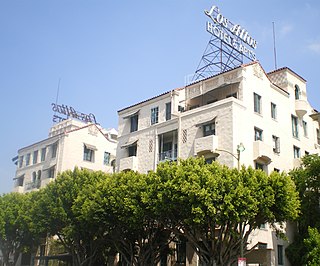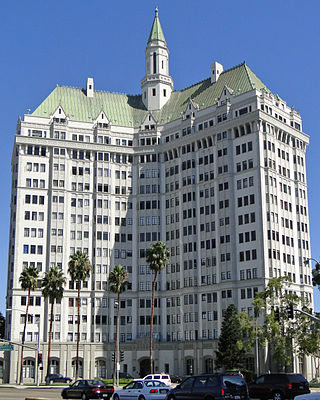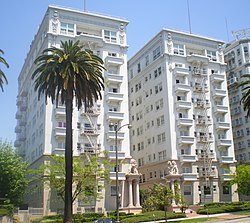
Westlake, also known as the Westlake District, is a residential and commercial neighborhood in Central Los Angeles, California, United States. It was developed in the 1920s. Many of its elegant mansions have been turned into apartments and many new multiple-occupancy buildings have been constructed.

Wilshire Boulevard (['wɪɫ.ʃɚ]) is a prominent 15.83 mi (25.48 km) boulevard in the Los Angeles area of Southern California, extending from Ocean Avenue in the city of Santa Monica east to Grand Avenue in the Financial District of downtown Los Angeles. One of the principal east–west arterial roads of Los Angeles, it is also one of the major city streets through the city of Beverly Hills. Wilshire Boulevard runs roughly parallel to Santa Monica Boulevard from Santa Monica to the west boundary of Beverly Hills. From the east boundary, it runs a block south of Sixth Street to its terminus.
Mid-Wilshire is a neighborhood in the central region of Los Angeles, California. It is known for the Los Angeles County Museum of Art, the Petersen Automotive Museum, and the Miracle Mile shopping district.

The Pellissier Building and adjoining Wiltern Theatre is a 12-story, 155-foot (47 m) Art Deco landmark at the corner of Wilshire Boulevard and Western Avenue in Los Angeles, California. The entire complex is commonly referred to as the Wiltern Center. Clad in a blue-green glazed architectural terra-cotta tile and situated diagonal to the street corner, the complex is considered one of the finest examples of Art Deco architecture in the United States. The Wiltern building is owned privately, and the Wiltern Theatre is operated by Live Nation's Los Angeles division.

Wilshire Park is a neighborhood in the Central Los Angeles region of Los Angeles, California.

Wilshire Center is a neighborhood in the Wilshire region of Los Angeles, California.

Myron Hubbard Hunt was an American architect whose numerous projects include many noted landmarks in Southern California and Evanston, Illinois. Hunt was elected a Fellow in the American Institute of Architects in 1908.

The Wilshire Boulevard Temple, known from 1862 to 1933 as Congregation B'nai B'rith, is a Reform Jewish congregation and synagogue, located at 3663 Wilshire Boulevard, in the Wilshire Center district of Los Angeles, California, in the United States. Founded in 1862, it is the oldest Jewish congregation in Los Angeles.

Granada Shoppes and Studios, also known as the Granada Buildings, is an imaginative, Mediterranean Revival and Spanish Colonial Revival style block-long complex consisting of four courtyard-connected structures, in Central Los Angeles, California. It was built immediately to the southeast of Lafayette Park in the Westlake District, in 1927.

Chateau Colline is an historic eight-unit apartment building on Wilshire Boulevard in the Westwood section of Los Angeles, California.

The Los Altos Apartments is a Mission Revival-style apartment building on Wilshire Boulevard in Los Angeles, California.

Security Trust and Savings, also known as Security Pacific Bank, is a highrise office building in Hollywood, California and built in 1921. The building was designed by the father and son design team of John and Donald Parkinson, who also designed some of the city's major landmarks, including Los Angeles City Hall and Bullocks Wilshire.

The Town House is a large former hotel property built in 1929 on Wilshire Boulevard, adjacent to Lafayette Park in the Westlake district of Los Angeles, California. After a long career as a hotel it operates today as low income housing.

{{Infobox NRHP | name = Villa Riviera | nrhp_type = | designated_other1 = Long Beach Historic Landmark | designated_other1_date = | designated_other1_number = | image = Villa Riviera.jpg | caption = | location = 800 East Ocean Boulevard,
Long Beach, California | area = | coordinates = 33°45′57.1″N118°10′57.6″W | locmapin = Los Angeles | built = 1928 | architect = Richard D. King | architecture = [[French Chateauesque[] Gothic Revival architecture|French Gothic]] | added = July 25, 1996 | refnum = 96000778 | website = https://www.villariviera.net/ }}

Samuel Tilden Norton, or S. Tilden Norton as he was known professionally, was a Los Angeles–based architect active in the first decades of the 20th century. During his professional career he was associated with the firm of Norton & Wallis, responsible for the design of many Los Angeles landmarks.

Wilshire Vista is a neighborhood in the central region of Los Angeles.

Beverly Grove is an area within the Beverly–Fairfax neighborhood in the Mid-City West region of Los Angeles, California.

The Saban Building, formerly the May Company Building, on Wilshire Boulevard in the Miracle Mile district of Los Angeles, is a celebrated example of Streamline Moderne architecture. The building's architect Albert C. Martin, Sr., also designed the Million Dollar Theater and Los Angeles City Hall. The May Company Building is a Los Angeles Historic-Cultural Monument. The building was operated as a May Company department store from 1939 until the store's closure in 1992, when May merged with J. W. Robinson's to form Robinsons-May. The building has been the home of the Academy Museum of Motion Pictures since 2021.

7th Street is a street in Los Angeles, California running from S. Norton Ave in Mid-Wilshire through Downtown Los Angeles. It goes all the way to the eastern city limits at Indiana Ave., and the border between Boyle Heights, Los Angeles and East Los Angeles.

























